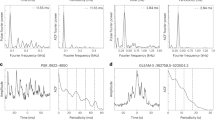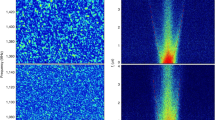Abstract
Pulsars are rotating neutron stars that produce lighthouse-like beams of radio emission from their magnetic poles. The observed pulse of emission enables their rotation rates to be measured with great precision. For some young pulsars, this provides a means of studying the interior structure of neutron stars. Most pulsars have stable pulse shapes, and slow down steadily (for example, see ref. 20). Here we report the discovery of long-term, highly periodic and correlated variations in both the pulse shape and the rate of slow-down of the pulsar PSR B1828-11. The variations are best described as harmonically related sinusoids, with periods of approximately 1,000, 500 and 250 days, probably resulting from precession of the spin axis caused by an asymmetry in the shape of the pulsar. This is difficult to understand theoretically, because torque-free precession of a solitary pulsar should be damped out by the vortices in its superfluid interior1,2.
This is a preview of subscription content, access via your institution
Access options
Subscribe to this journal
Receive 51 print issues and online access
$199.00 per year
only $3.90 per issue
Buy this article
- Purchase on Springer Link
- Instant access to full article PDF
Prices may be subject to local taxes which are calculated during checkout



Similar content being viewed by others
References
Shaham, J. Free precession of neutron dtars: role of possible vortex pinning. Astrophys. J. 214, 251–260 (1977).
Sedrakian, A., Wasserman, I. & Cordes, J. M. Precession of isolated neutron stars. I. Effects of imperfect pinning. Astrophys. J. 524, 341–460 (1999).
Bailes, M., Lyne, A. G. & Shemar, S. L. in Planets Around Pulsars (eds Phillips, J. A., Thorsett, S. E. & Kulkarni, S. R.) 19–30 (Astronomical Society of the Pacific Conference Series, San Francisco, 1993).
Wolszczan, A. & Frail, D. A. A planetary system around the millisecond pulsar PSR 1257+12. Nature 355, 145– 147 (1992).
Rasio, F. A., Nicholson, P. D., Shapiro, S. L. & Teukolsy, S. A. An observational test for the existence of a planetary system orbiting PSR 1257+12. Nature 355, 325– 326 (1992).
Wolszczan, A. Confirmation of Earth-mass planets orbiting the millisecond pulsar PSR 1257+12. Science 264, 538–542 (1994).
Kennel, C. F. & Coroniti, F. V. in Solar System Plasma Physics . Vol. 2 Magnetospheres 105–181 (North-Holland, Amsterdam, 1979).
Lyne, A. G. in Pulsars: Problems and Progress (eds Johnston, S., Walker, M. A. & Bailes, M.) 73–81 (IAU Colloquium 160, Astronomical Society of the Pacific, San Francisco, 1996).
Tkachenko, K. Stability of vortex lattices. Sov. Phys. JETP 23, 1049–1056 (1966).
Goldstein, H. Classical Mechanics 205–213 (Addison-Wesley, Reading, Massachusetts, 1980).
Weisberg, J. M., Romani, R. W. & Taylor, J. H. Evidence for geodetic spin precession in the binary pulsar 1913+16. Astrophys. J. 347, 1030– 1033 (1989).
Arzoumanian, Z. Radio Observations of Binary Pulsars: Clues to Binary Evolution and Tests of General Relativity. Thesis, Princeton Univ. (1995 ).
Cordes, J. M. in Planets around Pulsars (eds Phillips, J. A., Thorsett, S. E. & Kulkarni, S. R.) 43–60 (Astronomical Society of the Pacific Conference Series Vol. 36, San Francisco, 1993).
Suleymanova, S. A. & Shitov, Y. P. Secular variations of the integrated pulse profile of, and torque on, PSR 2217+47: Precession of the neutron star? Astrophys. J. Lett. 422, 17–20 (1994).
D'Alessandro, F. & McCulloch, P. M. Long-term timing observations of four southern pulsars. Mon. Not. R. Astron. Soc. 292, 879–886 ( 1997).
Mereghetti, S. A spin-down variation in the 6 second X-ray pulsar 1E 1048.1-5937. Astrophys. J. 455, 598–602 (1995).
Melatos, A. Bumpy spin-down of anomalous X-ray pulsars: The link with magnetars. Astrophys. J. 519, L77–L80 (1999).
Alpar, M. A., Anderson, P. W., Pines, D. & Shaham, J. Vortex creep and the internal temperature of neutron stars. I. General theory. Astrophys. J. 276, 325– 334 (1984).
Roberts, D. H., Lehar, J. & Dreher, J. W. Time series analysis with CLEAN. I. Derivation of a spectrum. Astron. J. 93, 968– 989 (1987).
Lyne, A. G. & Graham-Smith, F. Pulsar Astronomy 14–22 (Cambridge, Univ. Press, 1998 ).
Acknowledgements
We thank D. J. Nice for providing the two-standard-profile frequency-domain fitting routine, M. Goss for obtaining the interferometric pulsar position, F. Graham Smith for reading of the manuscript and F. Camilo for discussions. I.H.S. received support from a Natural Sciences and Engineering Research Council of Canada postdoctoral fellowship.
Author information
Authors and Affiliations
Corresponding author
Rights and permissions
About this article
Cite this article
Stairs, I., Lyne, A. & Shemar, S. Evidence for free precession in a pulsar. Nature 406, 484–486 (2000). https://doi.org/10.1038/35020010
Received:
Accepted:
Published:
Issue Date:
DOI: https://doi.org/10.1038/35020010
This article is cited by
-
Timing and emission variation of PSR J1733−3716
Astrophysics and Space Science (2020)
-
Long-term variations of X-ray pulse profiles for the Crab pulsar: data analysis and modeling
Science China Physics, Mechanics & Astronomy (2020)
-
Microglitches in radio pulsars: the role of strange nuggets
Astrophysics and Space Science (2020)
-
Prediction Methods in Solar Sunspots Cycles
Scientific Reports (2016)
-
Magnetic Field Generation in Stars
Space Science Reviews (2015)
Comments
By submitting a comment you agree to abide by our Terms and Community Guidelines. If you find something abusive or that does not comply with our terms or guidelines please flag it as inappropriate.



